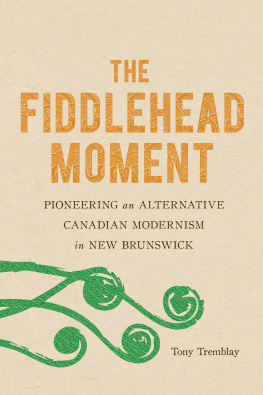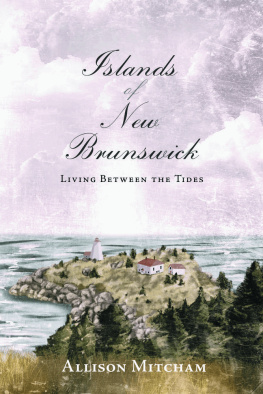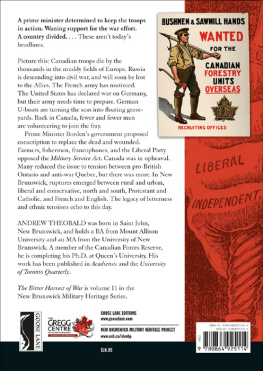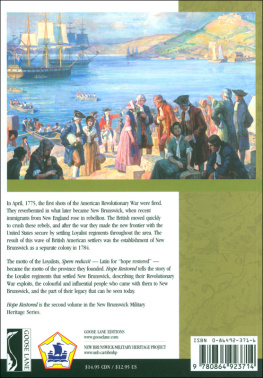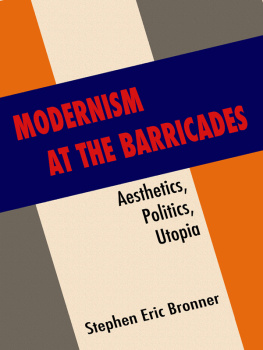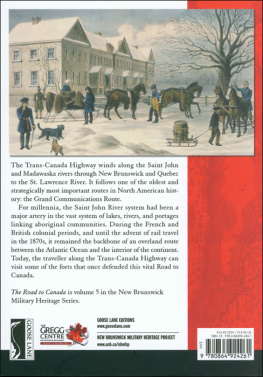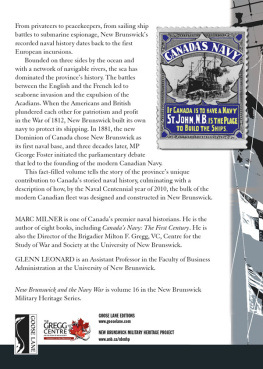
THE FIDDLEHEAD MOMENT
The Fiddlehead Moment
Pioneering an Alternative Canadian
Modernism in New Brunswick
TONY TREMBLAY
McGill-Queens University Press
Montreal & Kingston London Chicago
McGill-Queens University Press 2019
ISBN 978-0-7735-5907-3 (cloth)
ISBN 978-0-7735-5908-0 (paper)
ISBN 978-0-2280-0054-9 (ePDF)
ISBN 978-0-2280-0055-6 (ePUB)
Legal deposit fourth quarter 2019
Bibliothque nationale du Qubec
Printed in Canada on acid-free paper that is 100% ancient forest free
(100% post-consumer recycled), processed chlorine free.
This book has been published with the help of a grant from the Canadian Federation for the Humanities and Social Sciences, through the Awards to Scholarly Publications Program, using funds provided by the Social Sciences and Humanities Research Council of Canada.
We acknowledge the support of the Canada Council for the Arts.
Nous remercions le Conseil des arts du Canada de son soutien.
Library and Archives Canada Cataloguing in Publication
Title: The Fiddlehead moment : pioneering an alternative Canadian modernism in New Brunswick / Tony Tremblay.
Names: Tremblay, M. Anthony (Michael Anthony), author.
Description: Includes bibliographical references and index.
Identifiers: Canadiana (print) 20190161078 | Canadiana (ebook) 20190161124 | ISBN 9780773559080 (paper) | ISBN 9780773559073 (cloth) | ISBN 9780228000549 (ePDF) | ISBN 9780228000556 (ePUB)
Subjects: LCSH: Modernism (Literature)New Brunswick. | LCSH: Canadian literatureNew BrunswickHistory and criticism.
Classification: LCC PS8131.N3 T74 2019 | DDC C810.9/97151dc23
This book was typeset by True to Type in 10.5/13 Sabon
For Ellen
Contents
Illustrations
.
.
.
.
.
.
.
.
Preface
Some years later Frank Baird, 96, wrote to the [University] Monthly from the Old Country[,] I was permitted to hear a lecture on The Literature of Canada. Fully three-fourths of the lecturers time was spent in talking of graduates of the U.N.B. Afterwards I was asked, Is it true that it is impossible to go to that college and not write poetry?
Fusing earth and rain
Unfolding scroll of green
Symbol of the sun
You are the brain of harmony
Tender fingers stretch
And midget leaves unfold
Subtle dream of Truth
You are a many-fingered thought.
In Canada today, New Brunswick is thought of in consequential terms: that is, as both recipient and construct of wealth transfers. As exemplar of the social eugenics of distributed federalism, it is frequently denigrated by a rising tide of neo-liberal sentiment that looks askance at its apparent inability to get ahead on its own. No less an authority than former New Brunswick premier Frank McKenna has popularized that view, stating frequently that New Brunswickers have to decide if were going to sit around [waiting] for someone else to look after us [i.e., Alberta] or are we going to take responsibility for looking after our own future. New Brunswick, in short, has been reduced to obituary and footnote, its deficiencies foremost in the local and national imagination.
How soon a nation forgets that New Brunswick was once in the Canadian literary vanguard. The first novel published in Canada by a native-born Canadian was written in the province, Julia Catherine Beckwith Harts St. Ursulas Convent (1824), which initiated the important task of fostering Canadas native genius in its humblest beginnings. A generation later, a national literature was cultivated on New Brunswick soil in the work of the Fredericton school of the Confederation poets. Charles G.D. Roberts, the Father of Canadian literature, and Bliss Carman, the countrys unofficial poet laureate, were especially influential. Robertss animal stories were widely imitated and his poetic evocations of place provided early glimpses into the psychic conditions of citizenship that Northrop Frye and Margaret Atwood would popularize generations later. Carmans precocious, if tentative, modernism was similarly lauded by poets such as Ezra Pound and Wallace Stevens, opening doors to the more daring mythopoeia of the McGill school of Canadian modernists. By the middle of the twentieth century, the Fiddlehead started publishing it is now one of the countrys longest-surviving literary magazines and a generation later Antonine Maillet became the first non-European winner of the prestigious Prix Goncourt. Today, New Brunswick authors Hermngilde Chiasson, David Adams Richards, and France Daigle, all Governor Generals Literary Award winners, are among the most unique stylists in the country.
The provinces contributions to the critical records of Canada and the Commonwealth are equally outstanding. Consider, first, George Parkins influence on a young Winston Churchill at Harrow, his lecture on imperial federation later fortifying Churchills wartime resolve.of Canadian Nationhood (1955), books that established an identity narrative that all subsequent critics had to address. Finally, in the literary realm, consider the stewardship of the groundbreaking Literary History of Canada. Two of its five original editors A.G. Bailey and Desmond Pacey were based in New Brunswick, and a third, Northrop Frye, spent his formative years in the province. In addition, a number of contributors to that seminal collection had New Brunswick roots. David Galloway, author of the opening chapter, was a member of the English Department of the University of New Brunswick (UNB), as was Fred Cogswell, who wrote four of the twenty-five chapters in the books second edition. When broadened to include the expatriates H. Pearson Gundy and Alec Lucas, both of whom taught in the province, New Brunswick scholars accounted for more than 25 per cent of the authors who contributed to the countrys most authoritative literary history. And, while that percentage was partly attributable to the unusual concentration of Canadianists on the east coast in mid-century, it is nevertheless significant for revealing the extent to which scholars from or associated with New Brunswick were at the forefront of formalizing the critical practice of Canadian literature.
Yet, despite the fact that New Brunswick writers and critics were influential in determining literary directions in the country one need only think of Robertss influence on Archibald Lampman, A.G. Baileys tutelage of a young John Sutherland, and Desmond Paceys and Malcolm Rosss shaping of the Canadian literary canon, to name just a few more examples the study of that influence, or of the incubation of a New Brunswick aesthetic, has been absent. While select authors have received attention, no critical study has ever been undertaken of how a New Brunswick aesthetic took shape in the province and how it complemented other movements elsewhere in the country. Miriam Waddingtons editorial work on John Sutherland reveals the consequences of that lack, her comment that theres no explaining a person like John he seemed to come from nowhere suggesting the necessity of initial spadework (for Sutherlands modernist roots were in New Brunswick). This book embarks on that spadework by examining the New Brunswick modernist aesthetic that coalesced in the middle decades of the twentieth century under the direction of A.G. Bailey, Desmond Pacey, and Fred Cogswell.
In doing so it will illuminate a corner of Canada that is currently defined more by lack than by the important and constructive roles its citizens played in pioneering a form of literary modernism that was markedly different from the urban modernism in Montreal and Toronto that we know so much about from central Canadian critics. Part renovation, part rescue, part reminder, the book aims to reintroduce a province that is less consequential now, and certainly less understood, than it was a century ago.
Next page
